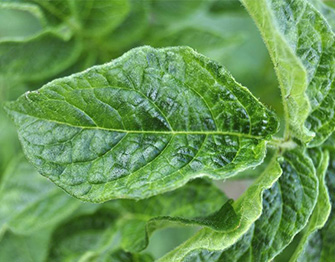Conditions
They can, depending on the virus, be spread by contact, insect or other vectors and groundkeepers can also be a significant source of infection. It is particularly important that seed crops are kept free from infection as they are the principle source of these diseases.
Identification of the cause of infection can be difficult as there are varietal differences in symptom expression for some of the viruses and similar symptoms may be observed with different viruses. Mixed infections can occur in which symptoms, usually severe, are different from those caused by each virus singly. Environmental conditions also affect symptoms.
Simple diagnostic field kits are available that can aid identification of many of these viruses and there are laboratories that offer comprehensive testing if required.
Potato Virus A (PVA)
PVA is present wherever potatoes are grown. Although generally considered of low importance compared to other viruses, widespread infection can cause significant yield losses. Symptom severity will depend upon the strain, potato variety, and environmental factors. Some varieties react with a mottle or mild mosaic of leaves. There are no tuber or root symptoms. It is tuberborne and non-persistently aphid-transmitted.
Potato virus M (PVM)
Symptoms of PVM infection will depend upon the strain, potato variety, and environmental factors. Symptoms following primary infection may include twisting and marginal chlorosis of leaflet tips and rolling, especially of upper leaves, another symptom is crinkled leaves. It is tuberborne and non-persistently aphid-transmitted.
Potato virus S (PVS)
PVS infection is often latent, but otherwise may vary with strain, potato variety, and environmental conditions. It is tuber-borne, mechanically transmitted and non-persistently aphid transmitted.
Potato virus V (PVV)
Cultivated potatoes are the only known natural host for PVV. Most potato varieties are resistant. Varieties which do become infected generally have very mild or no visual symptoms. It is tuber-borne and non-persistently aphid-transmitted.
Potato Virus X (PVX)
PVX may be very widely distributed principally because it causes either no or very mild symptoms of infection. However, mixed infection with PVA, PVY or PVS may cause severe symptoms. Some varieties are resistant to many strains of the virus. Although tuber-borne and mechanically transmitted very readily, it is not effectively transmitted by aphid or other insect vectors.
General control methods
Selecting certified prebasic or basic grade seed and resistant varieties will greatly reduce the risk of infection. Roguing of seed crops and controlling volunteers and groundkeepers is good practice. Control of insect vectors, particularly with products with repellent action, is useful. Virus testing is available and particularly advisable for farm saved seed.
